Visiting Indigenous tribe Bribri in Talamanca
Together with my friend Pablo, we were picked up at Cariblue hotel after breakfast to go on another exciting tour with Terraventuras travel agency. Once all registered at the office in Puerto Viejo, we hopped in the van again and the journey into the unknown could start …
When driving to Bribri, we saw some banana plantations with bananas covered with blue plastic bags that are not organic. Unfortunately, I was very familiar with them as it was not the first time I saw them. However, we could also see some smaller local farms with only organic bananas and no plastic bags … Thank God!
”This village is called Bribri and the language they speak too. The inhabitants here have their own way of living and many have organic farms where they grow fruit and vegetables. Then they sell them at the market to earn living. Most of them are not pure indigenous any more, but of mixed blood.” the guide started explaining the basic details about the Bribri in Talamanca.
The first Bribri family
When getting out of the van, we already learned that a Bribri Shaman cured 40 people with cancer just feeding them organic food and medicinal plants for 20 – 25 consecutive months they spent living in the area with the Bribri. Also students from the Universities come here to study the herbs and their use as spending time with a shaman or an Awa, a Bribri’s doctor right in the rainforest is definitely more effective than studying from the books.
Bribri people mostly produce cacao, coffee and corn but the area has been still infected by the monilia fungus killing the cacao trees like in other parts of the Caribbean (like I learned on the Caribeans chocolate tour.)
First we could walk around the main house, check out the handicrafts the family makes and play with kids. I have seen similar arts already a few weeks ago when I got a chance to spend marvelous time with Embera tribe in Panama but I was still woved by their manual skills.
However, it was my first time to see sloths made out of coconut shells and drums with real snake skin on top. That would make for interesting souvenirs, right? :)
”The roofs of these houses survive for 20 to 25 years as they cook inside and the smoke kills the parasites in the wood which helps with its preservation.” I overheard the guide saying this in English to a couple that was on the tour with me when I was still thinking about the tribal differences.
After the first contact with the family life, we started hiking deeper into the rainforest where our Bribri guide Walter explained us the use of some medicinal plants. Not only him, but also his young daughter Natalie were both barefoot. Natalie was super sweet, sometimes shy for photos but definitely less shy than any other tribal kid I’ve seen.
Some of the plants we saw:
- Walking palm with roots outside of the ground that fight for sunrise and thus can move up 1 meter around. The palm sticks are used to build houses as they are strong and flexible. In the past, it was also used to make arrows to shoot animals.
- Chicha plant to make a drink or just to chew it. The famous drink is made of fermented corn with sugar cane to get a strong sweet taste. ”The more you ferment, the sweeter and stronger it gets.” smiled our guide.
- Cacao plant – we ate the fruit – the pulp around the beans is what you eat and for many of the people on the tour it was their first time eating, or even seeing the fruits. The skin of the cacao fruit is awesome also for any cuts and purification of body. Chocolate in the past was used to live in harmony with older tribes; and also used in rituals. Cacao was sacred and it was not taken/drank at just any occasion but when it was something important, such as when someone died. To know when the cacao fruit is ready, just check out the coming yellow color on it. The cacao trees we saw here were endemic from Costa Rica.
”Cacao beans: You ferment them first, then dry under the Sun until it makes a popcorn sound, then you get a cacao paste and then you can add any flavor you’d like, such as orange, ginger or coconut. White cacao butter is good for sunburn or any other skin problems.”
- Guaba – the first time I ate guaba fruit from Inga species right from the tree in the rainforest – what you eat is the white puffy cotton pulp around the seeds hidden in a big long bumerang looking green shape. It’s sometimes called the ice-cream-bean, or guama. And these guaba beans were huge, like 3 times longer than guaba I knew. You open the beans and just eat the white pulp – similarly to cacao beans – but you do not eat seeds at all. Unfortunately, you cannot really fulfill your stomach eating just one guaba bean but it makes for a tasty and healthy snack!
- Basil that tasted and smelled like wild oregano but I was told that it was one of the 3 kinds of basil plants that grow in the area. Tea made of it is great for headaches.
- Guanabana – one of my favorite tropical fruit – leaves are good to make a tea to fight against cancer.
- A lot of big poisonous bullet ants were around us so watching our Bribri guides walking barefoot just like that was a bit scary. The bullet ants sting and it hurts like a bullet, hence the name. Some tribes put a man’s hand into the bullet anthill and if he is brave enough to hold it there, he can get married. Some tribes in Honduras also make a bee to sting them into the forehead when they have a headache so it disappears. I was not sure I wanted to know more about these odd traditions, but at least what I took with me was the following knowledge:
- On the full moon, the Bribri in Talamanca cut the taraña lianas to construct houses (other time of the month the termites would eat it.)
- The best for female days (period) are the smashed leaves of chsimuritri made into a drink (the leaves even look like that – they have red dots all over them).
- On a fallen tree we spotted huge caterpillars – a male and a female one that eat roots and old trees.
Then we got into a sacred place with a lot of stones in circles where Walter explained us the world creation in Spanish (with our Terraventuras guide translating into English) – how the Bribri believe the God created humans and the world itself. These stones are a replica of circles in the high mountains of Talamanca where the Bribri tribe was created originally.
I was trying to listen to the whole explanation by Walter but his daughter was running around and making faces at me, such a cutie.
- Next to the sacred place there was this super massive tree ojoche giving me a lot of energy and it looked to me like matapalo I knew from Blue Osa.
- Mastate is used for clothes after drying up under the sun.
- Sambok tree is good for sloths and monkeys that eat the leaves as they are a bit poisonous and thus kill the parasites in the bodies of the animals and they are smart enough to know it. Back in time, the natives used to cut these leaves and use the white liquid from it to kill fish when fishing so they would float on top making it easier to catch.
- Jackfruit has sweet seeds that are a sort of aphrodisiac – we learned when a blue morpho flew around.
- Gumbo limbo, or the so called Naked Indian or Arbol de turista is called that way because of its peeling skin which resembles of the tourist skin when they come to the beach for the first time and all sunburn :D The naked tree bark is boiled to make tea which renews the blood system. The tree always changes its bark so no parasites can get into it. Montezuma birds like to make nests on this tree.
- Yoyo for blood pressure.
On the way back to the house we saw Walter’s wife grinding corn with a big stone. The medicinal plant learning was definitely more interesting with little Natalie running around and tasting all the plants with us while smiling into my camera.
Afterwards, Walter explained us the world creation in detail using drawings on a fabric.
Visiting second Bribri family
- Custaño is used for diarrhea.
- Carao tree is good for anemia – a sweet liquid resembling honey is made out of the black fruit that looks like guaba fruit.
- Achiote – like I mentioned above, it has natural red colour and gives a flavor to food but it’s also used for coloring the handicrafts and clothes. We played a little bit with it, Luis painted our faces red – guys like warriors and women as with make-up on.
- Pejiballe wood used for arrows (and great salsa is made out of the plant too – we loved it at Puerto Pirata.)
”In the past when women learned how to grind the cacao beans, they could get married” Luis laughed when we walked to a little house in the garden to watch Doña Leticia grinding it. (well, I guess I would never get married then as the stones are super heavy haha.)
We learned in the garden:
- A tea made of Lemongrass is good for cold or you can put it into a bath.
- 3 kinds of achiote: outside and inside is red (used for arts and cooking), green in the outside and red in the inside, or yellow on the outside and red inside (used for rituals and ceremonies, not for eating.)
- Muralla exotica (exotic wall) is like jasmine and its leaves are used for toothache (just chew 5 or 6 leaves to relieve the pain). Or when the flowers are blooming, you can smash some of them in water and bath in it – it’s supposed to be an aphrodisiac, such a strong one that if you walk in front of a man you like after bathing with muralla exotica, he will become your lifelong partner so think twice before doing so :D
- Turmeric and ginger roots are good for stomachache, both aphrodisiac and full of antioxidants.
- Fruta milagrosa – I’ve tasted before is the miracle fruit that makes everything you eat after eating this fruit taste sweet, even a lemon gets a sweet taste.
- Artemisa for inflammation.
- Ortiga (stinging nettle) in Spain and Mexico is made into a soup for blood circulation, bone and muscle pain – just put a leave where it hurts you, it will burn your skin like nettles, you will get a sort of allergy, feel hot, then 20 minutes afterwards, the pain is all gone.
- Gavilana is a bitter plant – you can smash it between your hands and put on mosquito bites. It’s also a green natural dye used for clothing (you have to boil it with water and then put clothes into the water to get the color.)
- Estragon (tarragon) is good for insomnia, a tea made out of it makes you sleep like a baby.
- Cinnamon good for diarrhea, throwing up, digestion, it’s a strong antioxidant.
- Yosko – for blue color (written with 2 dots above both o; azul de mata is its other name.)
- Hiel de tepescuinte (konobicha) is great for stomachache and killing the parasites. Just use 2 or 3 leaves for 3 days or boil roots to get rid of pain in your tummy.
- Kucho – interesting about this is that it has no smell when burning but when you switch off the fire, it smells a lot.
”Hernan Cortes and the Mayas made cacao peace with cacao beans and cacaua = the Spaniards interpreted it wrong thinking they were talking about caca de agua but in reality it was a God’s drink.”
After the amazing tour with Luis, we hopped into the car and drove a bit more to get to our last stop to cool down in a waterfall. It was my second time hiking down to this waterfall and after 2 years it did not change much (except a few more plastic bags, bottles and cans swimming in the water I did not like to see.)
Like my first time there, I did not have my big camera to take photos. Back in 2012 I only had a small waterproof camera that doesn’t take nice photos, and now all my batteries were gone so I had to use my smartphone to get at least some photos.
I was more than happy to spot some poisonous red frogs jumping around us even though it was almost impossible to take a nice photo of them that was not blurry.
Anyway, I did some yoga very briefly as I forgot a towel and didn’t want to make the car seats wet. it was painful not to swim in the waterfall again but at least I stretched some muscles while the others enjoyed cooling off.
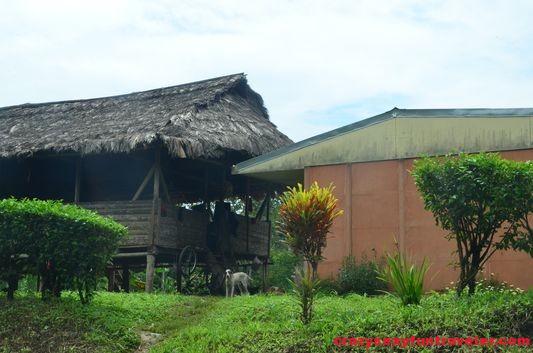
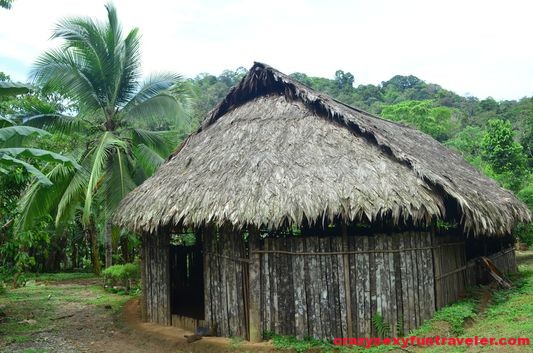
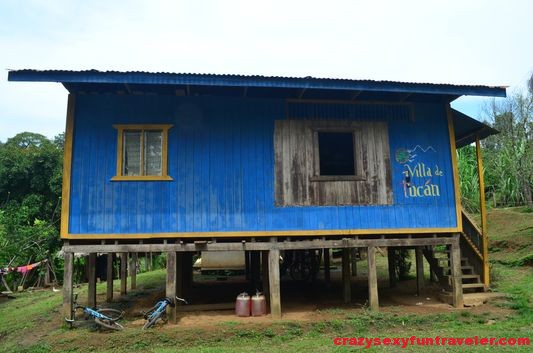
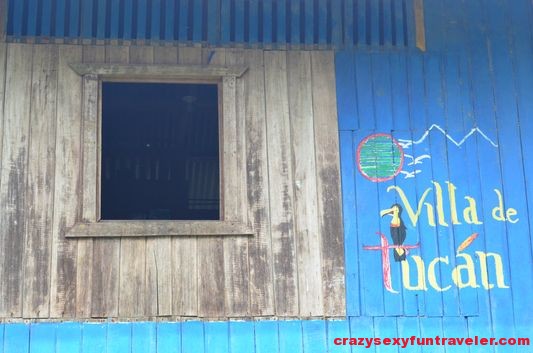
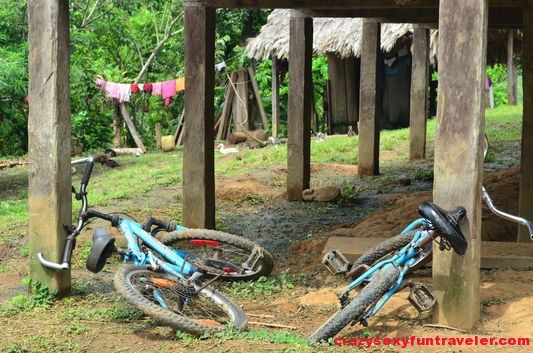
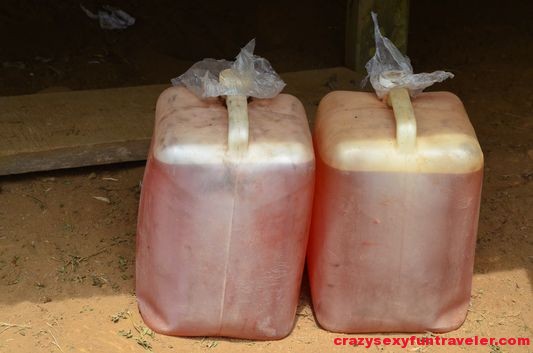
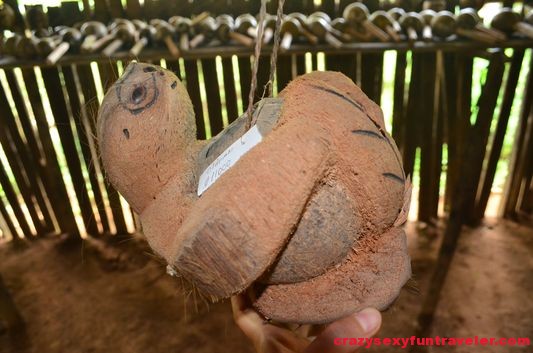
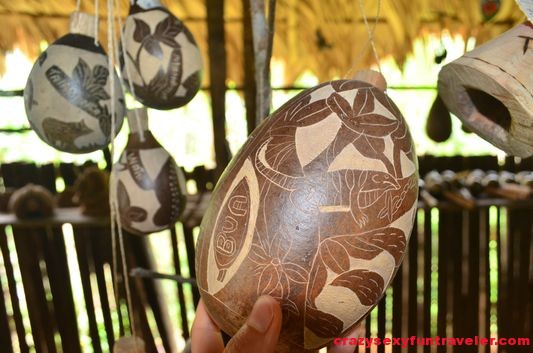
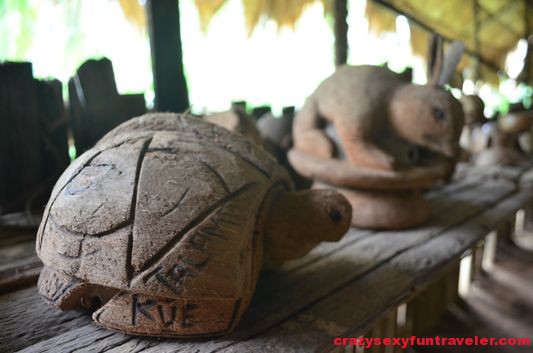
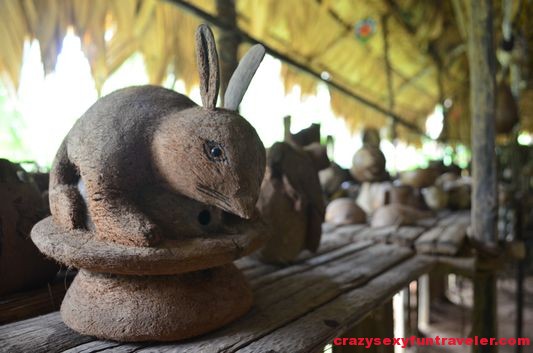
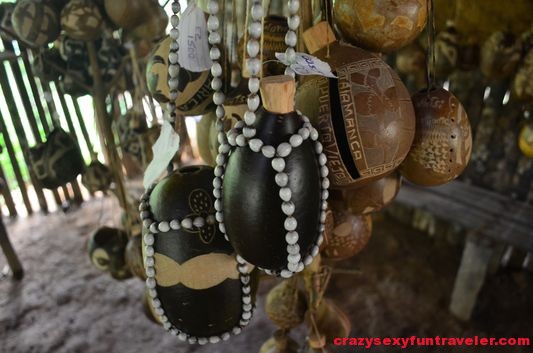
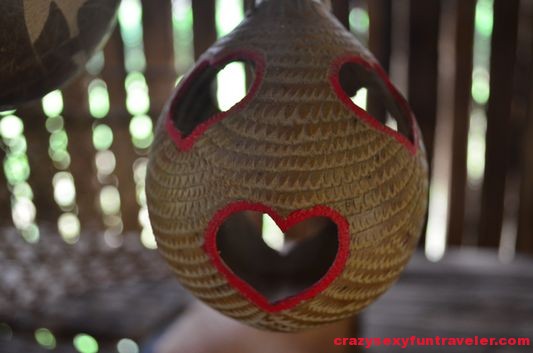
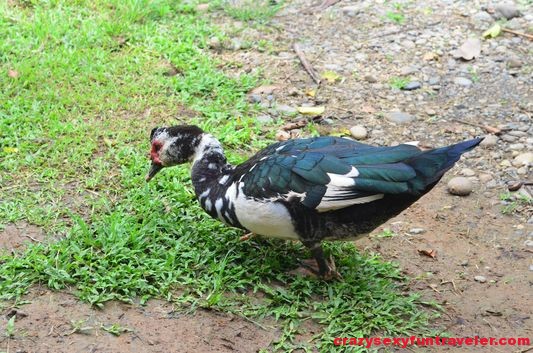
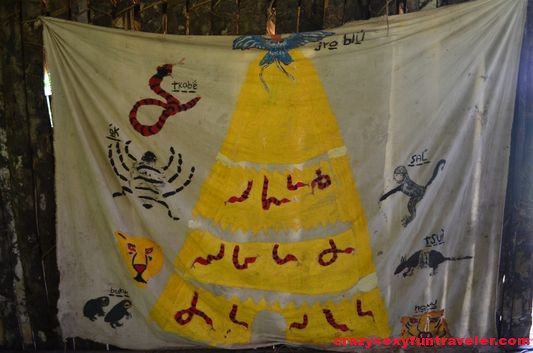
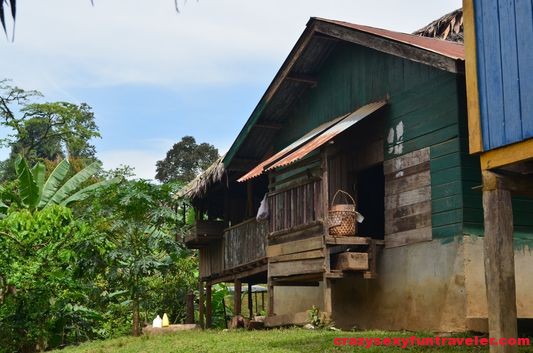
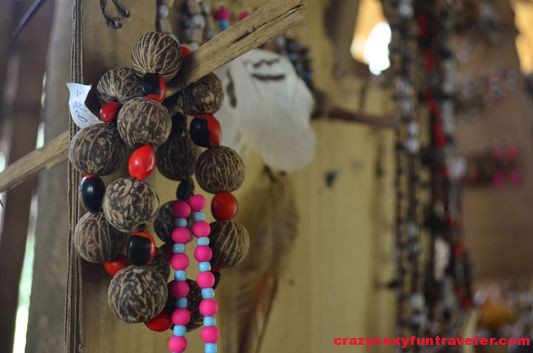
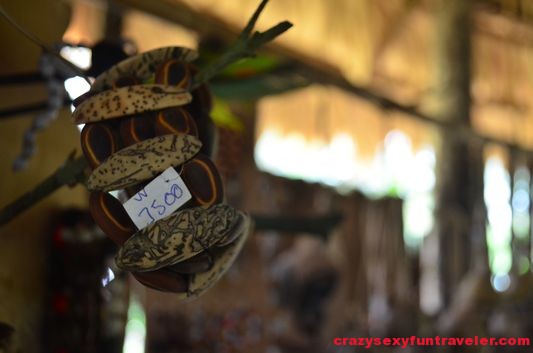
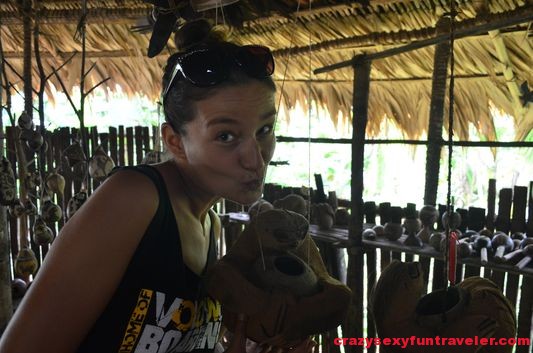
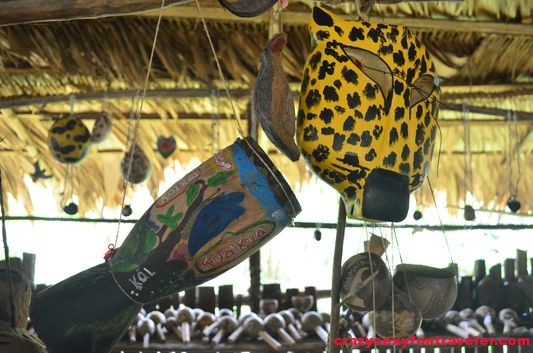
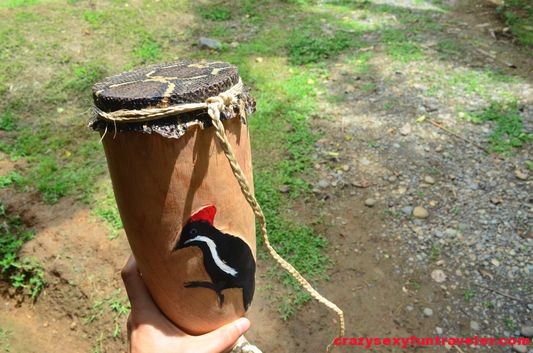
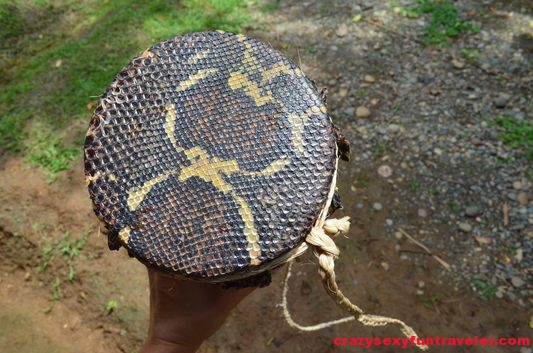
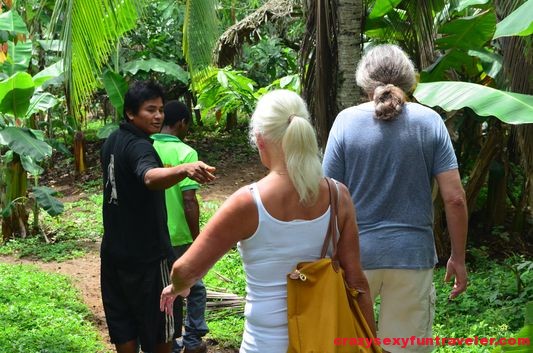
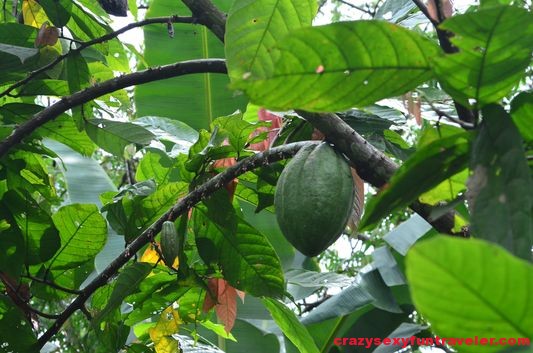
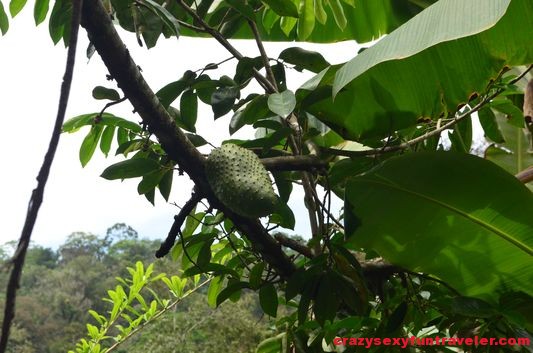
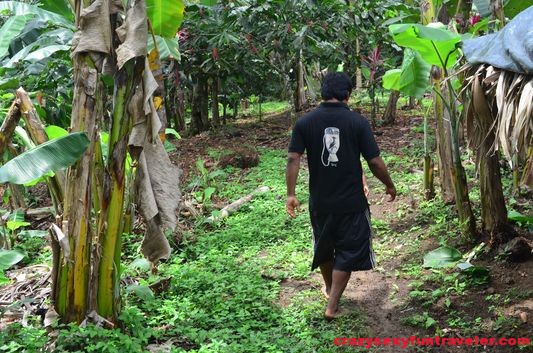
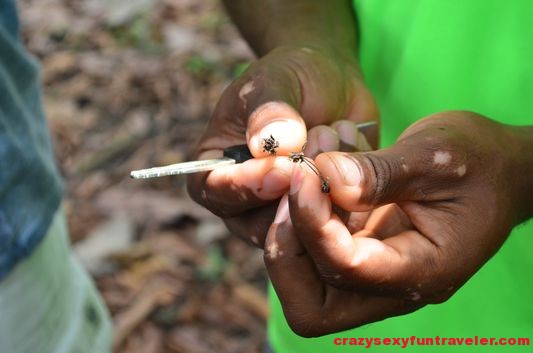
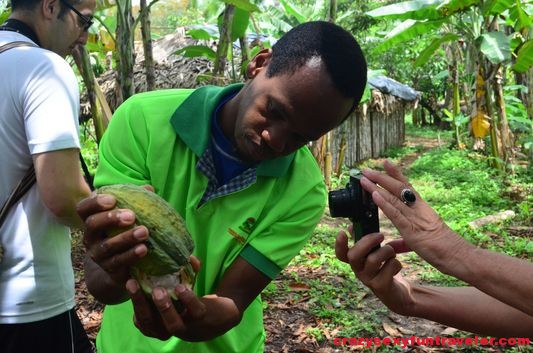
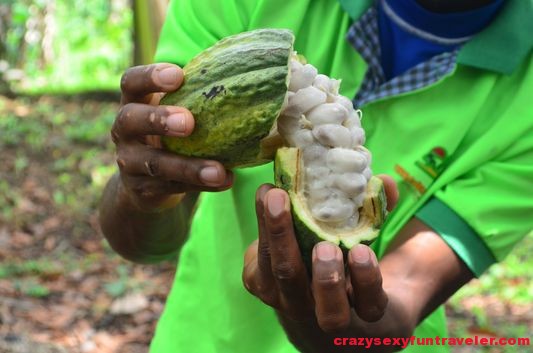
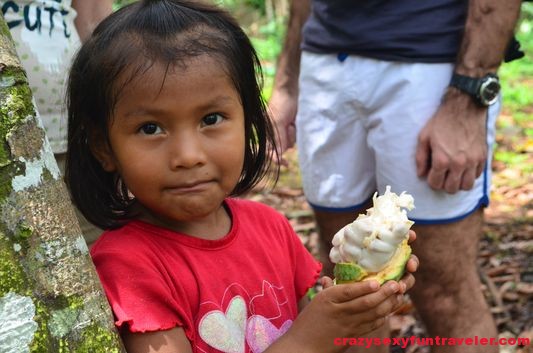
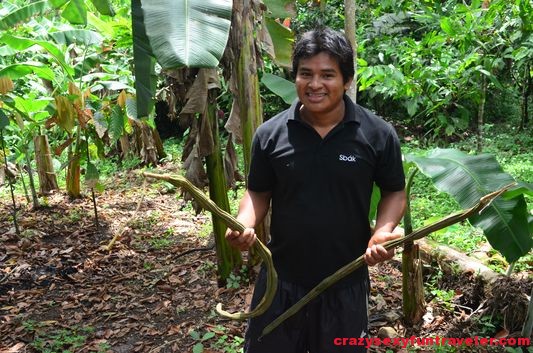
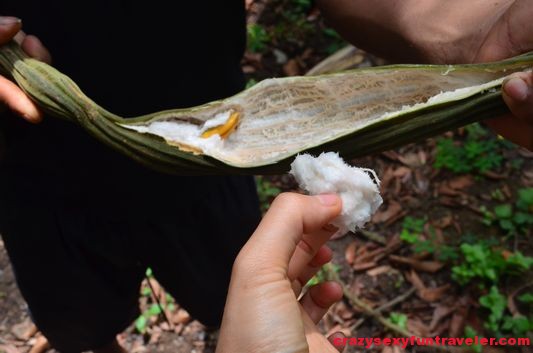
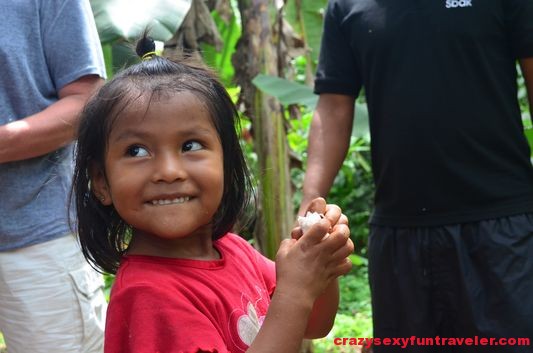
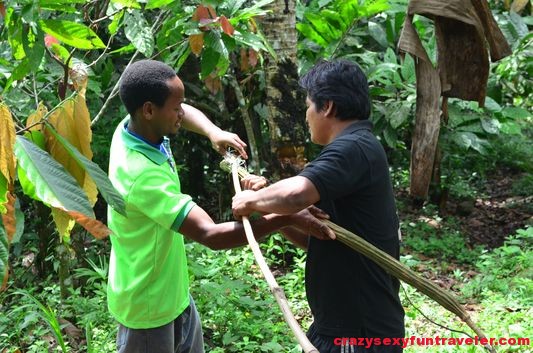
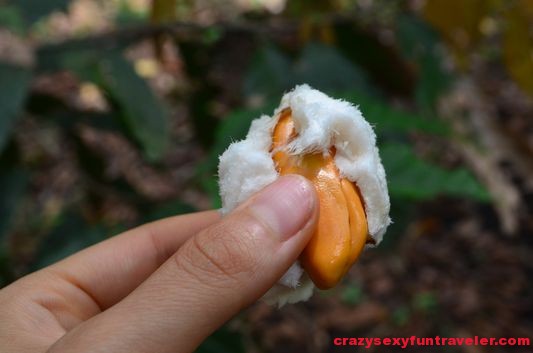
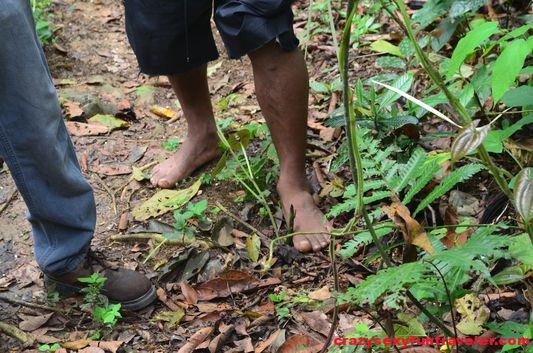
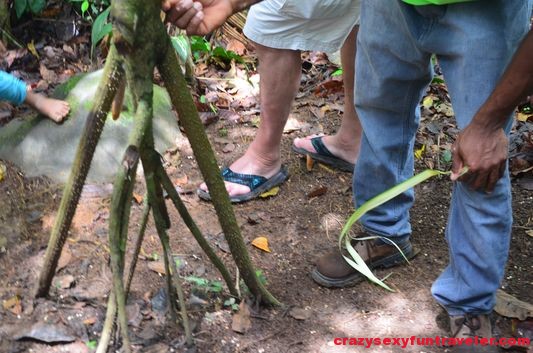
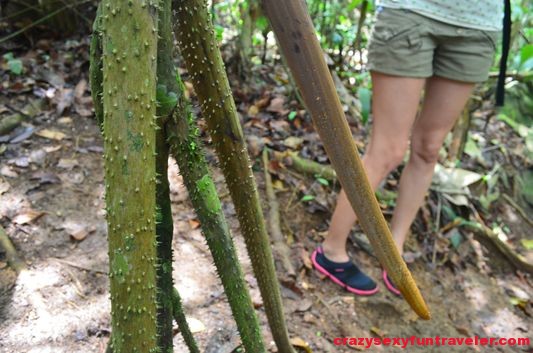
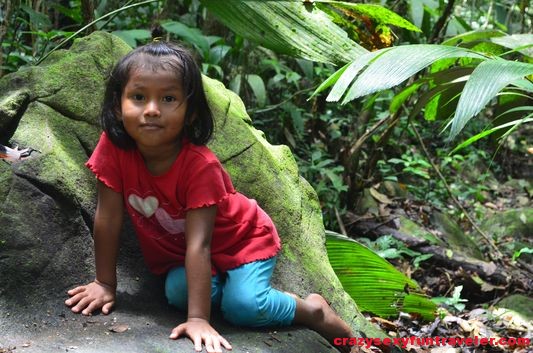
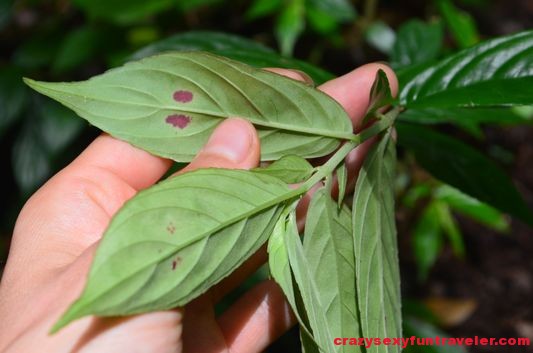
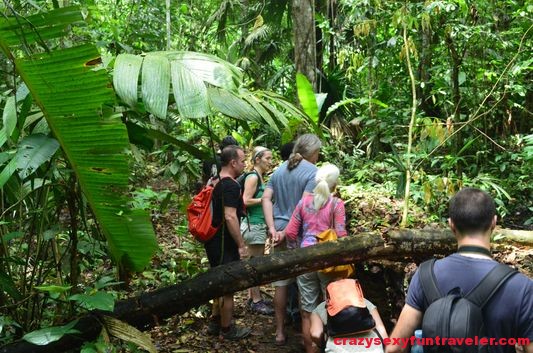
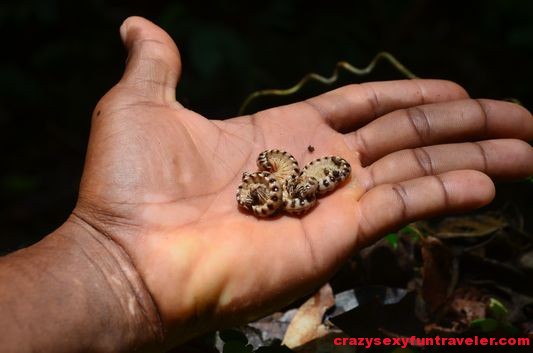
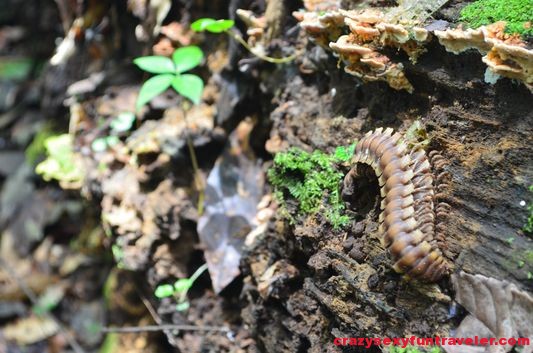
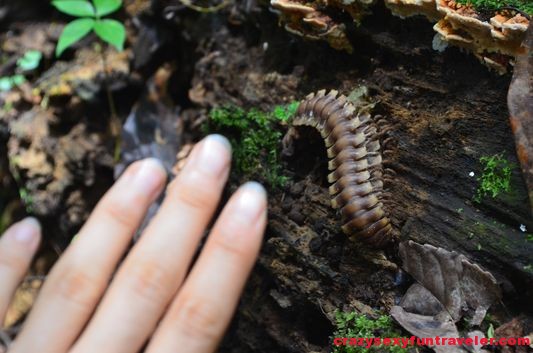
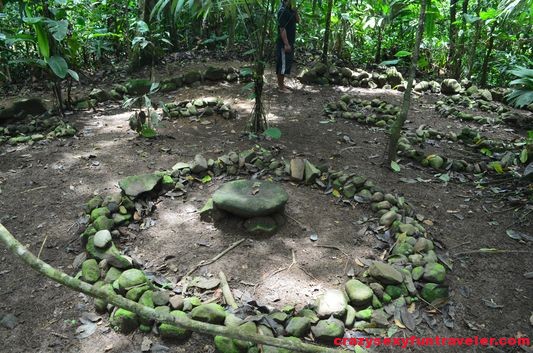
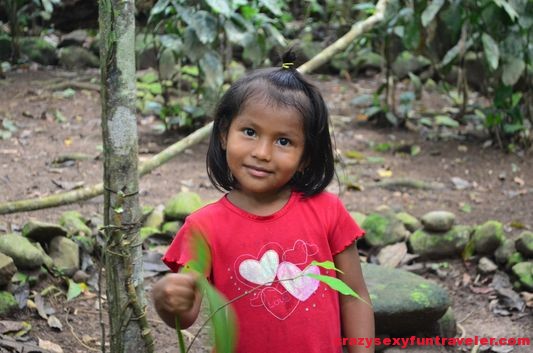
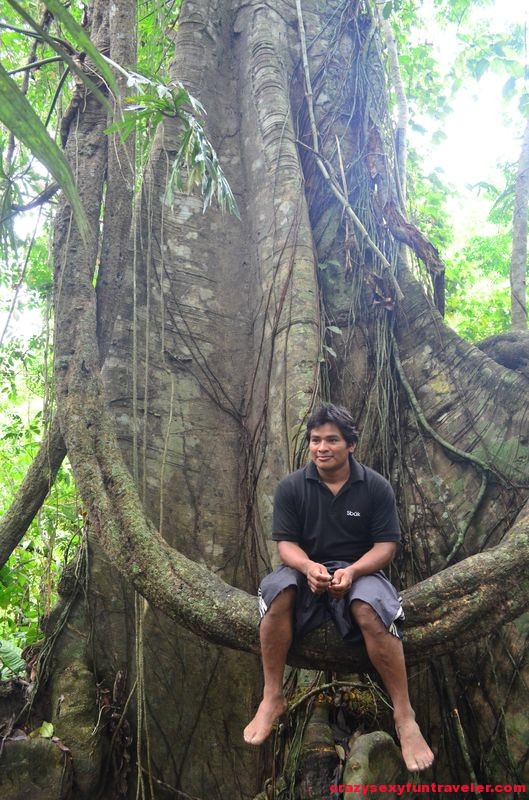
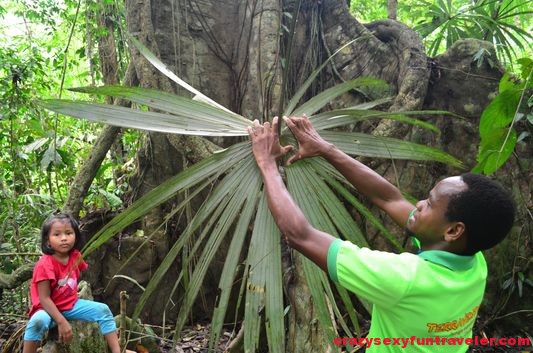
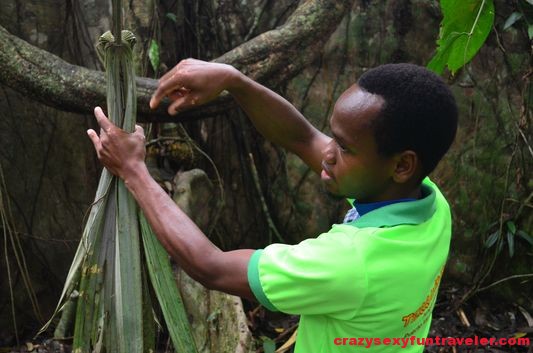
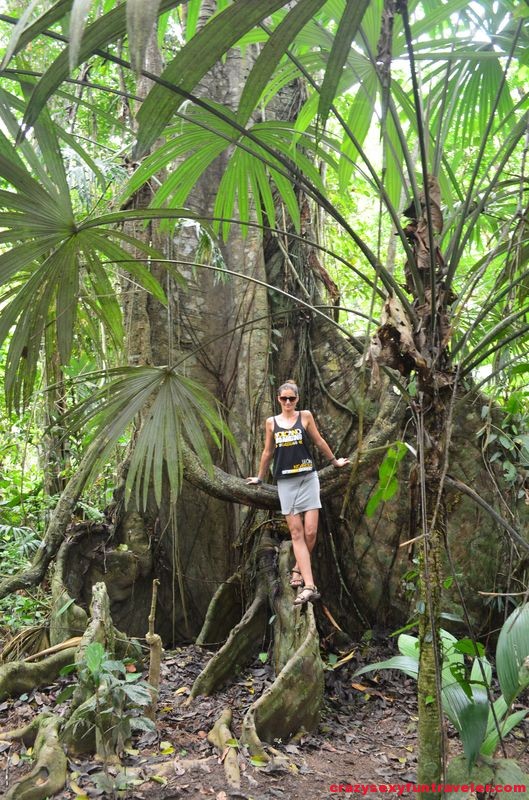
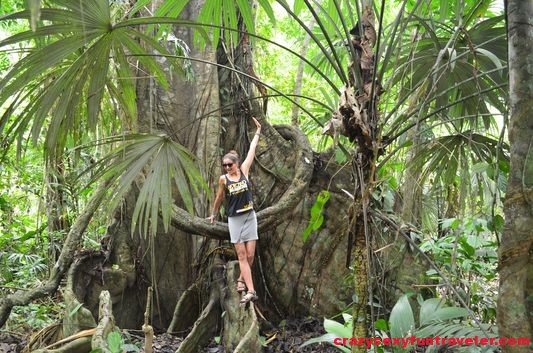
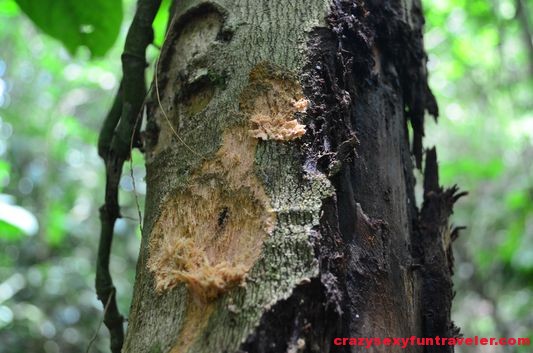
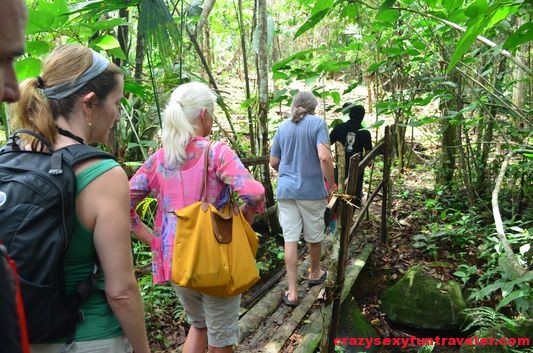
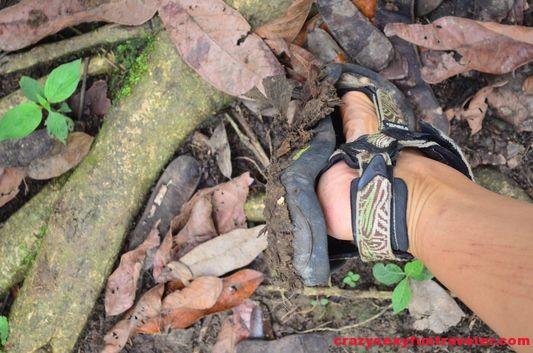
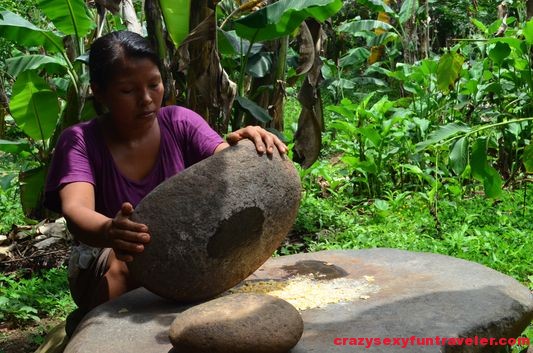
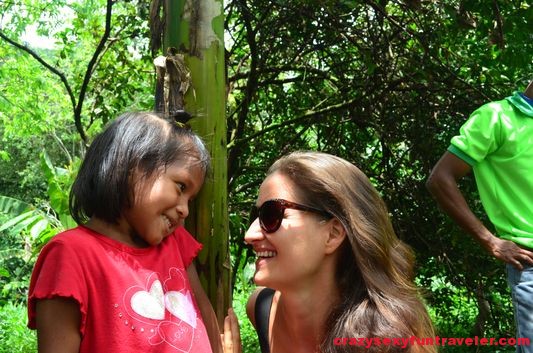
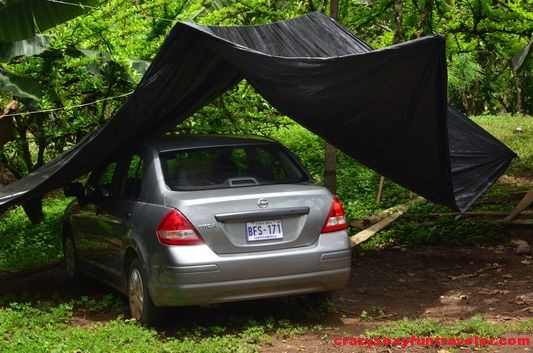
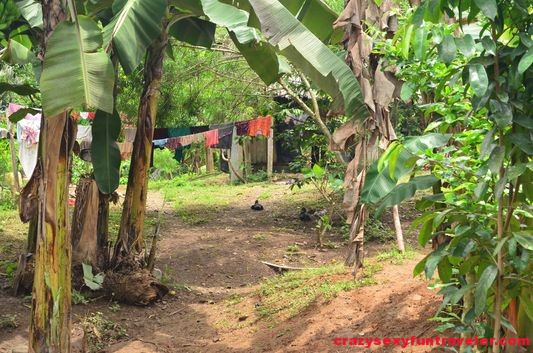
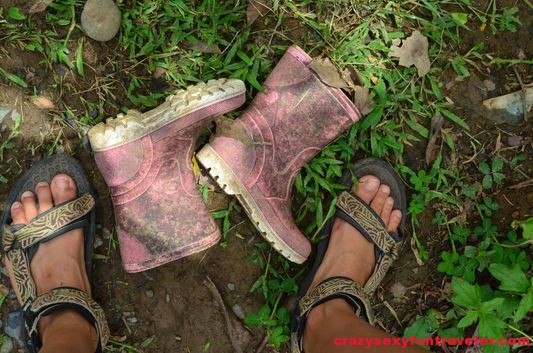
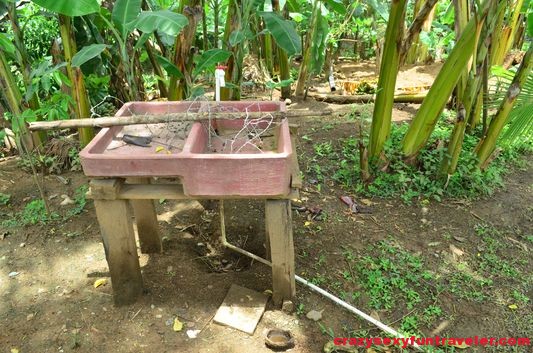
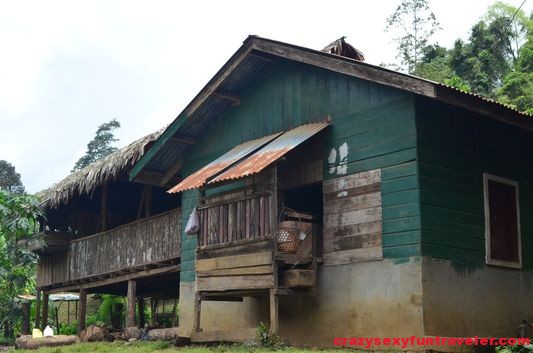
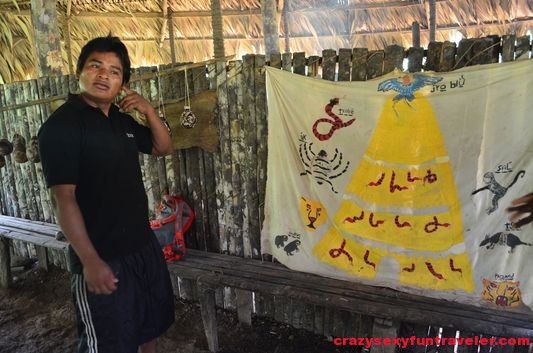

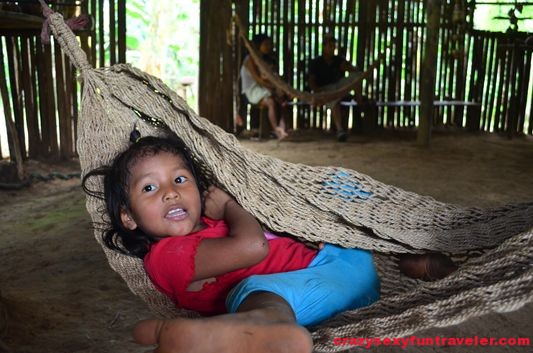
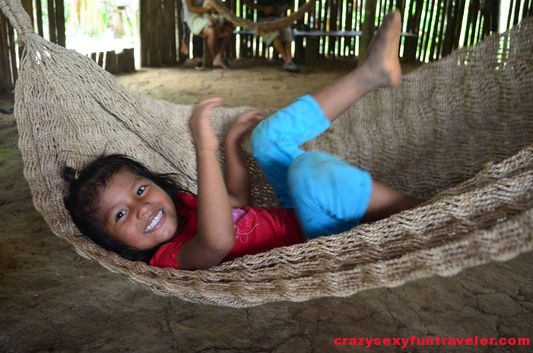
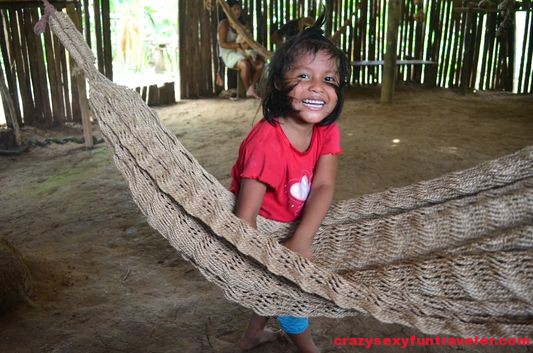

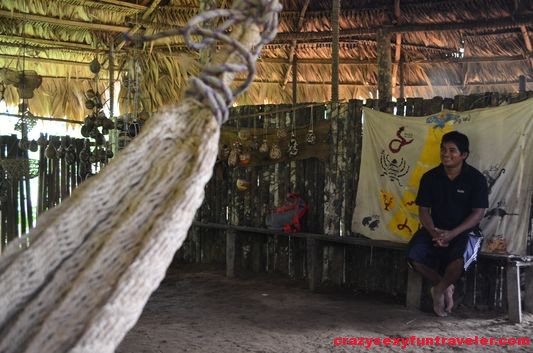
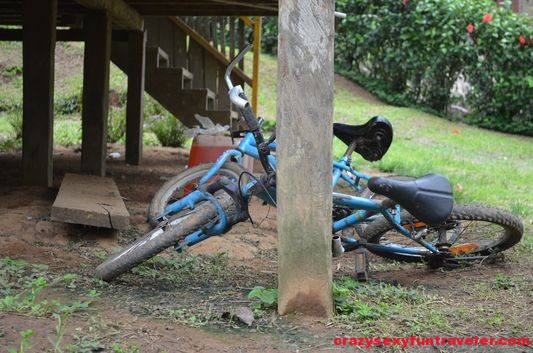
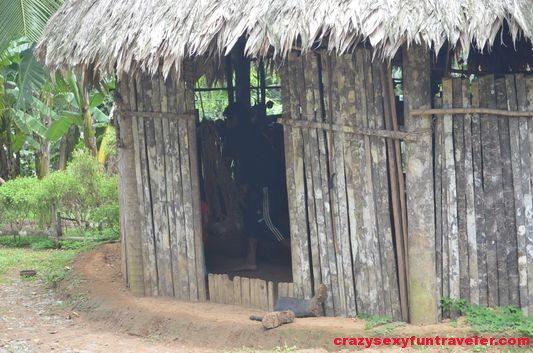
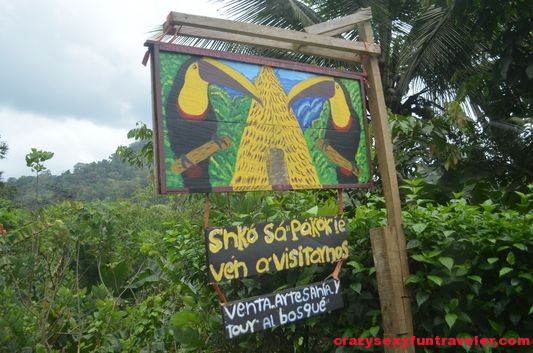
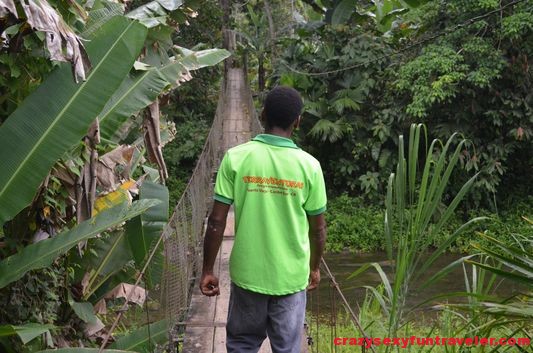
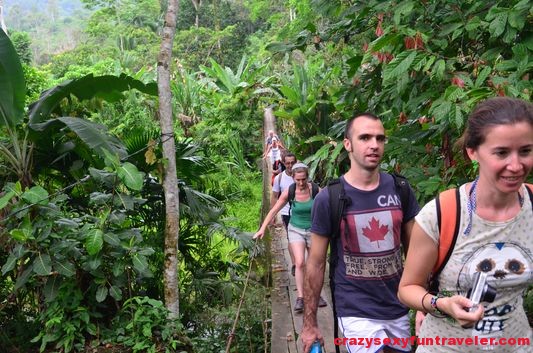
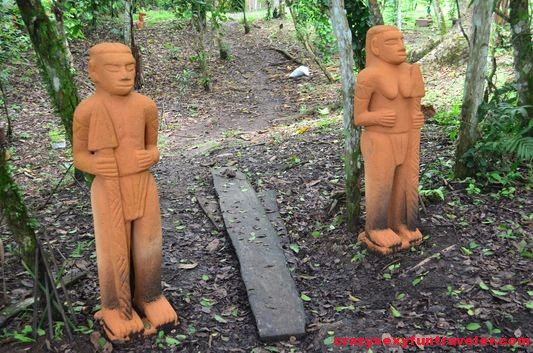
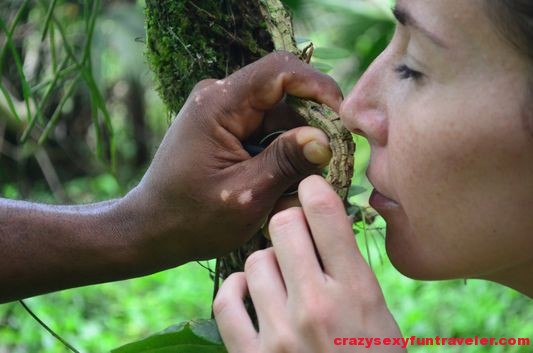
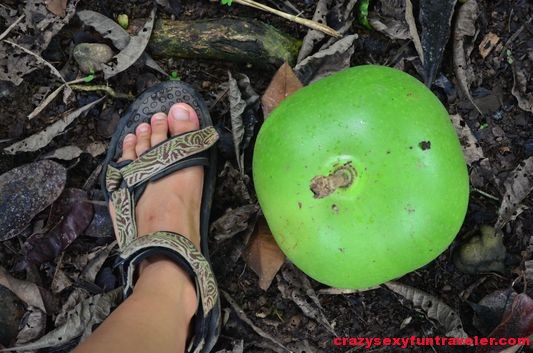
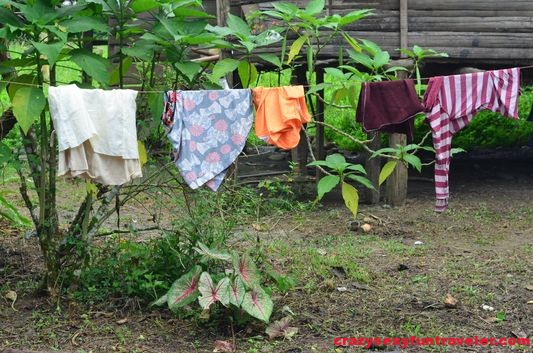
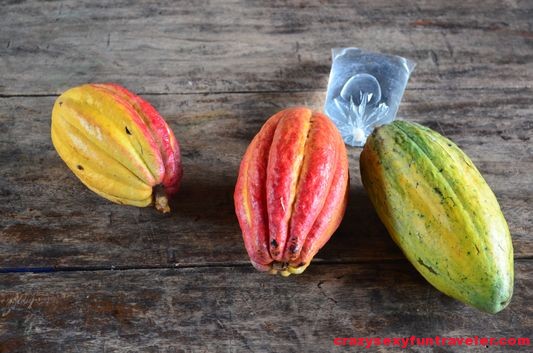
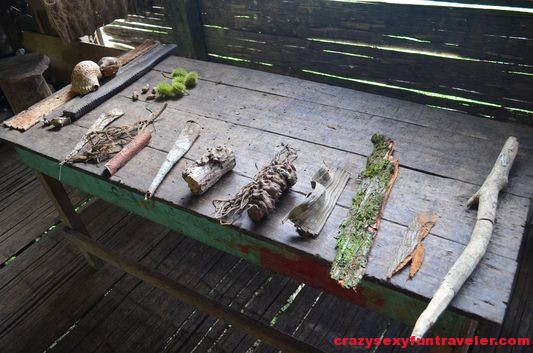
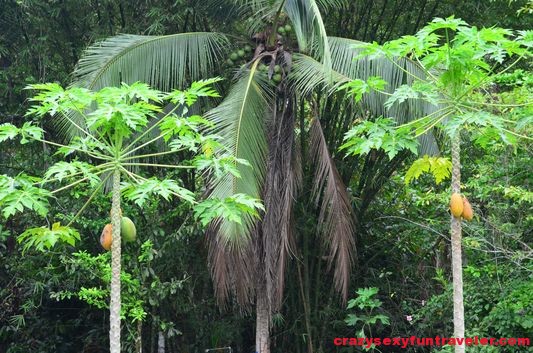
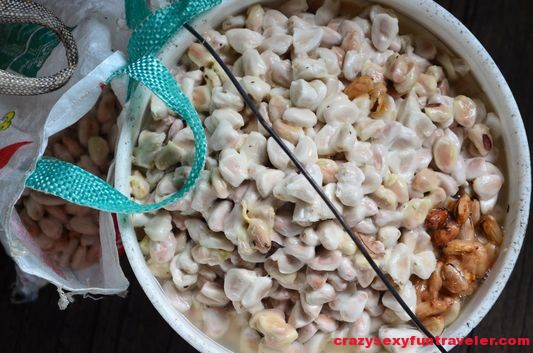

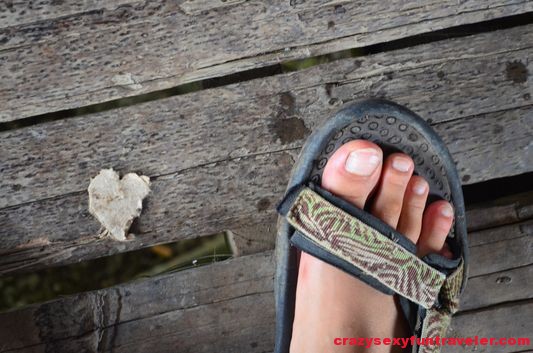
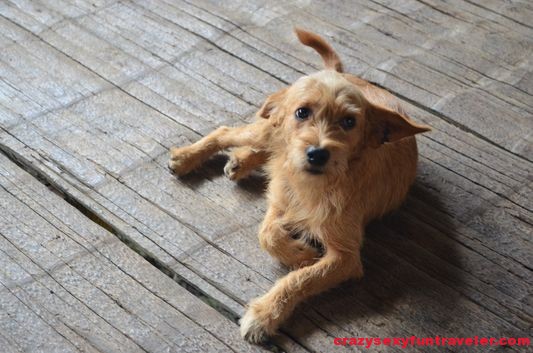
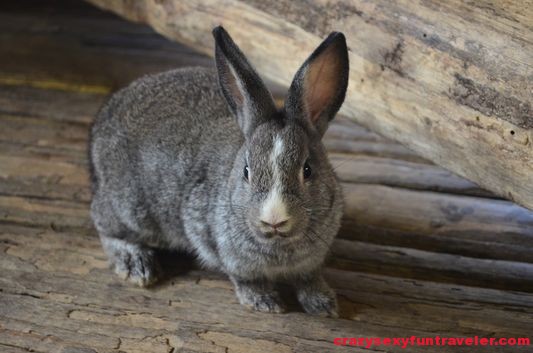
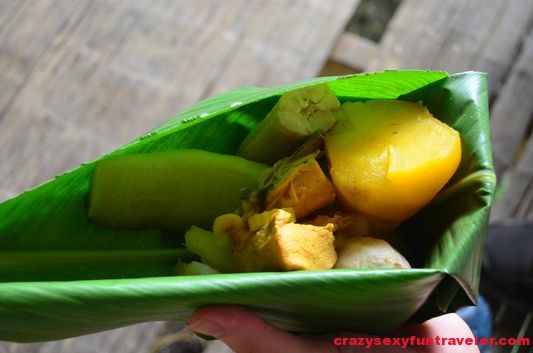
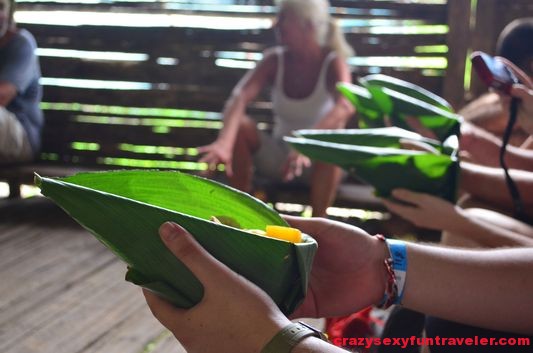
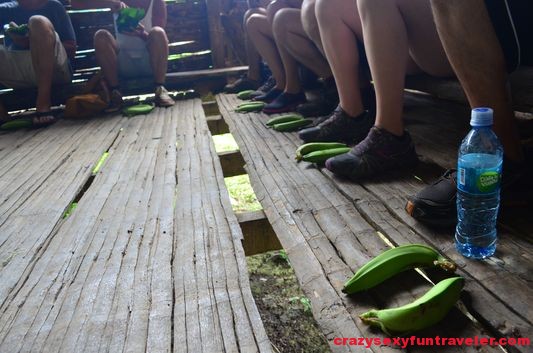
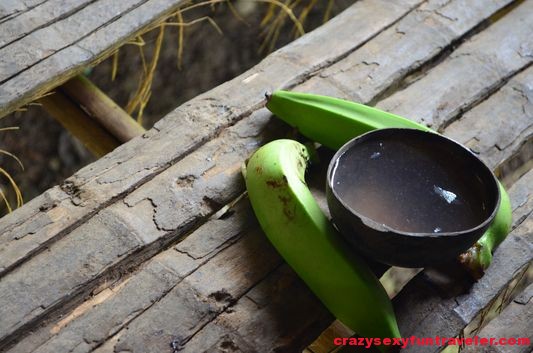
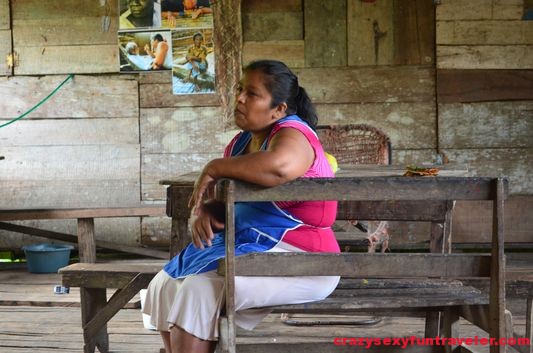
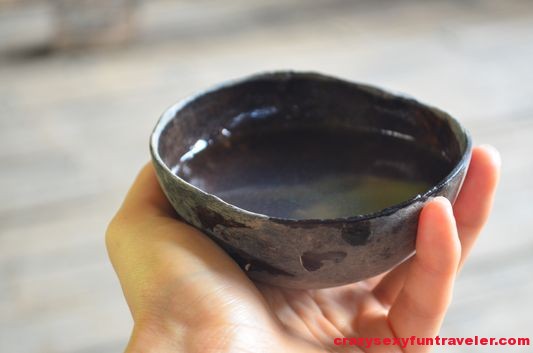
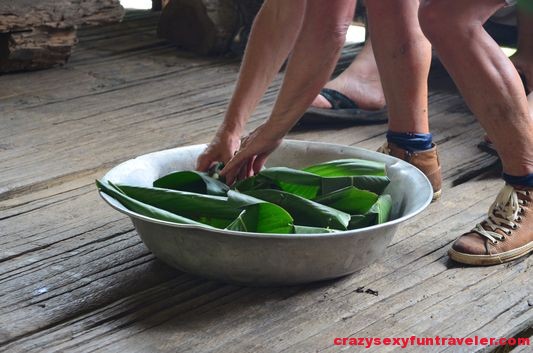
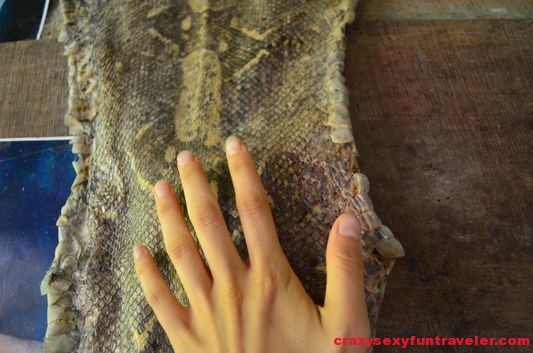
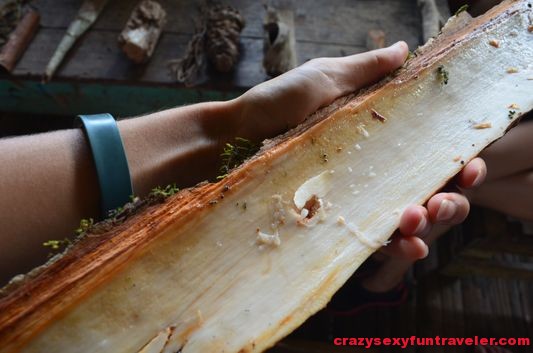
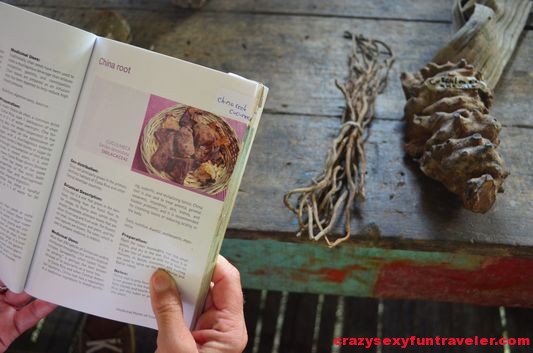
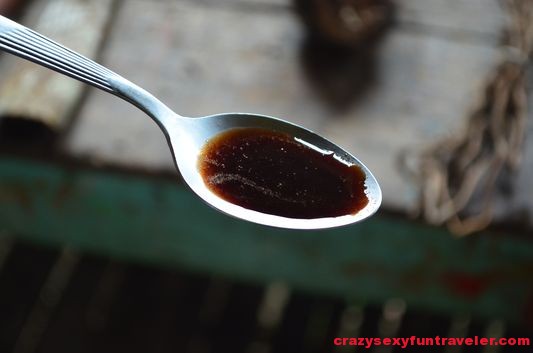
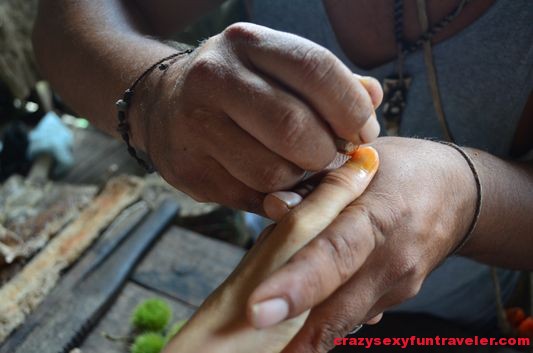
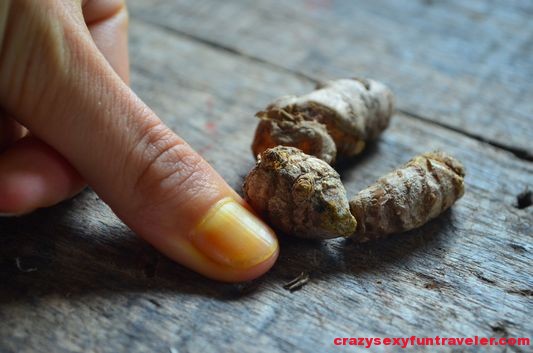
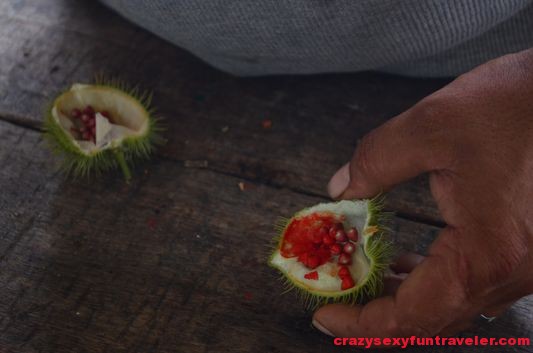
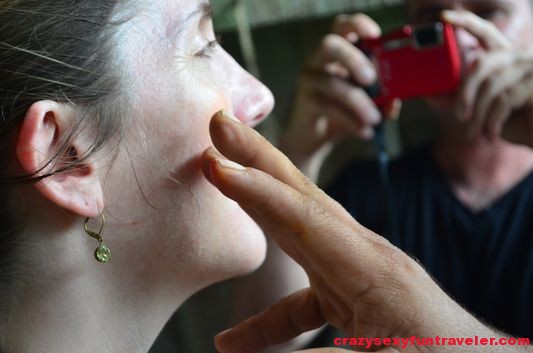
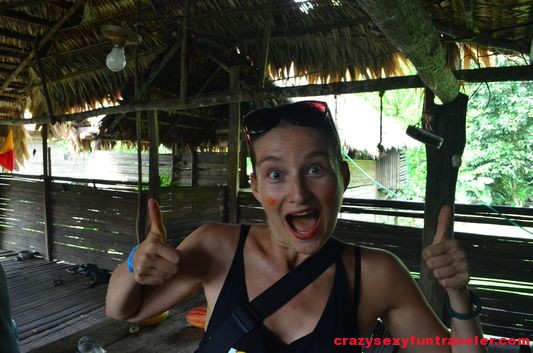
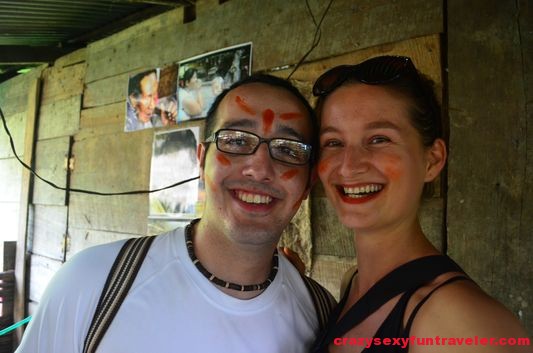
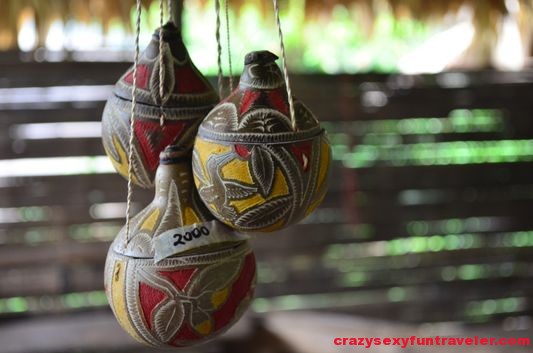
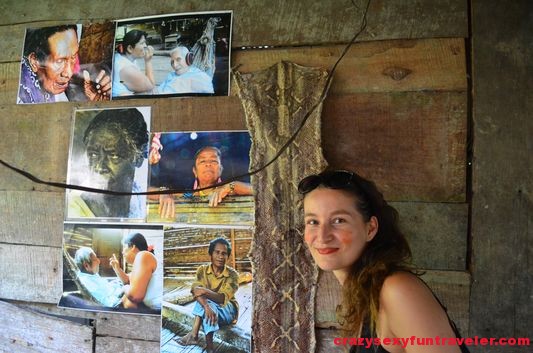
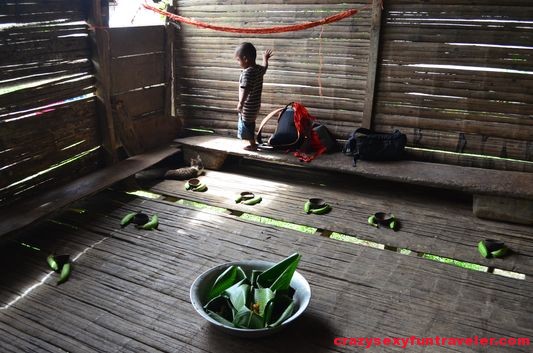
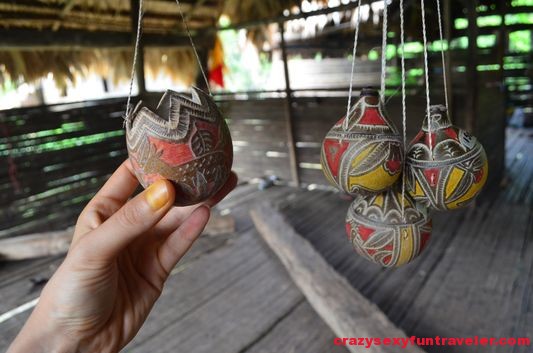

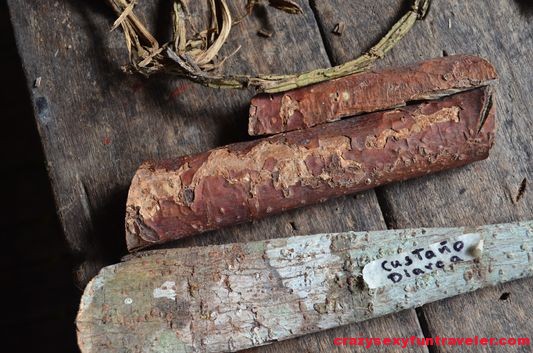
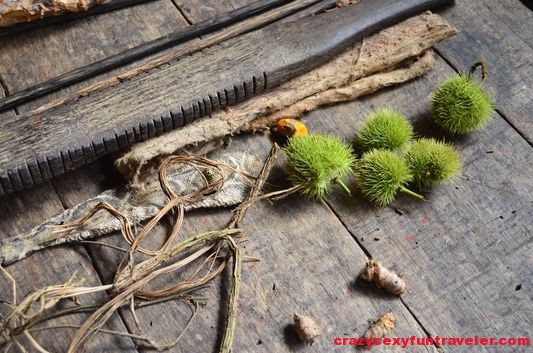
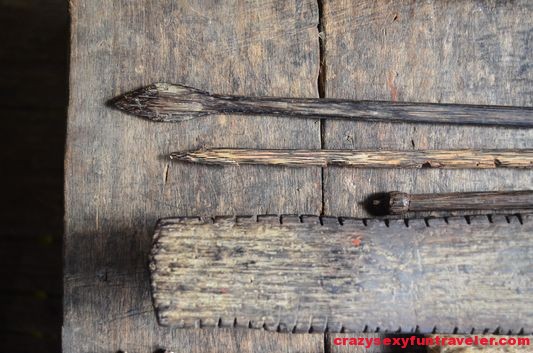
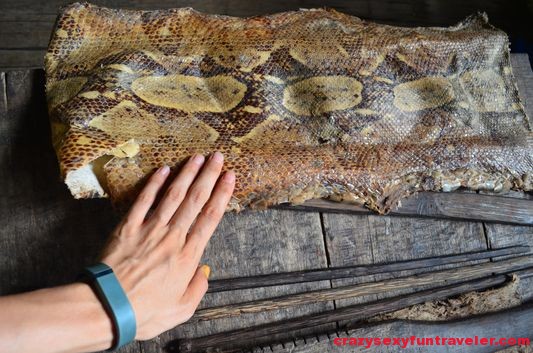
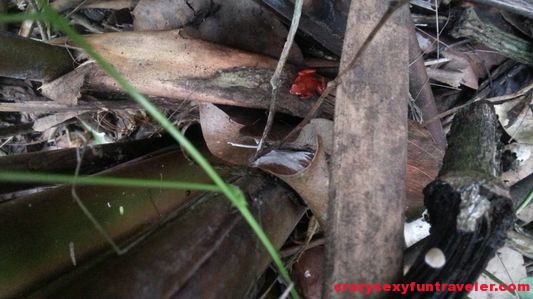
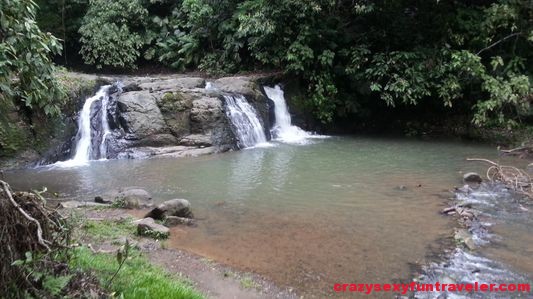
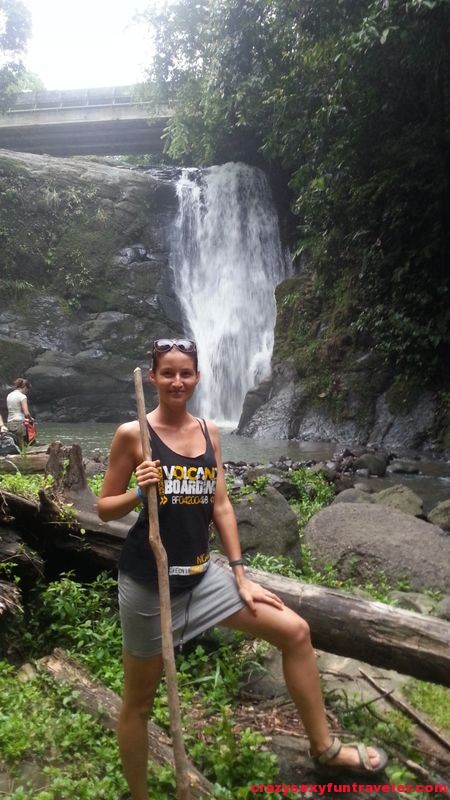
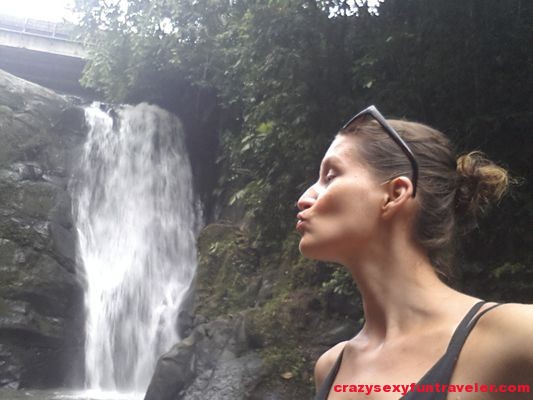
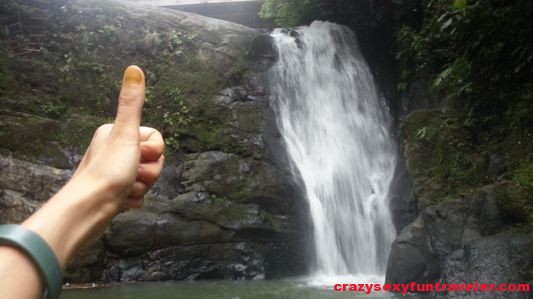
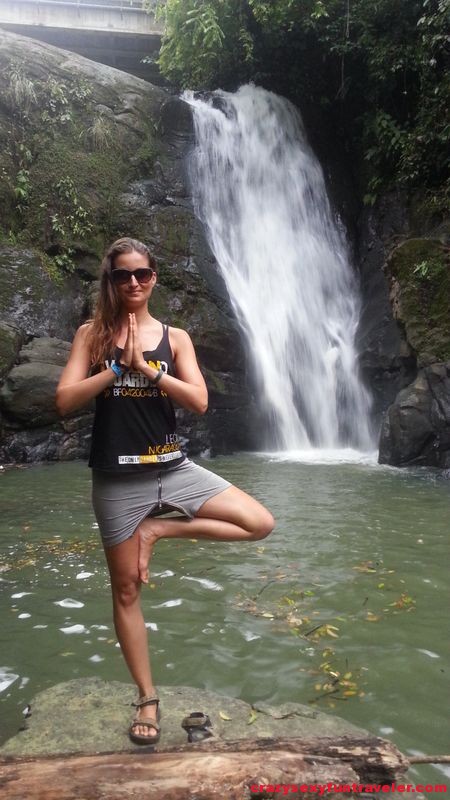

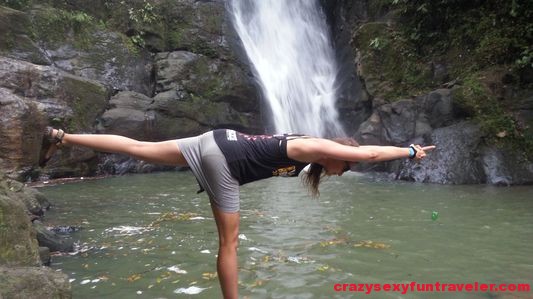

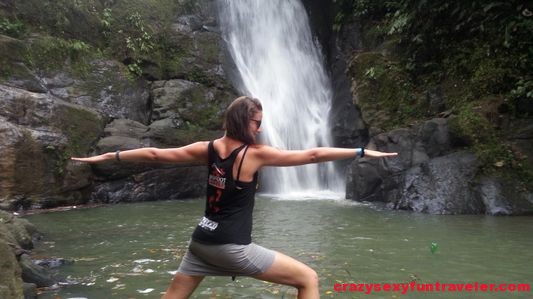
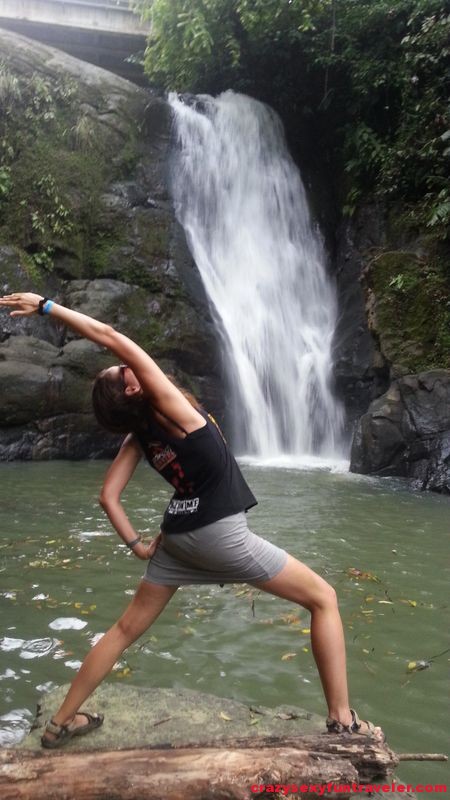
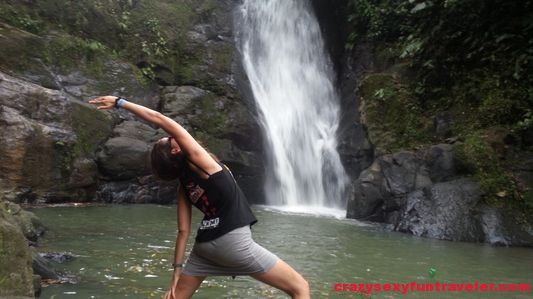
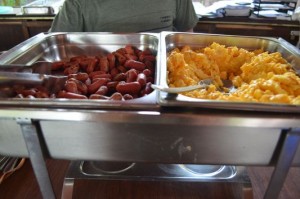
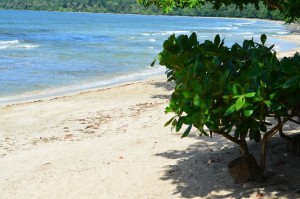
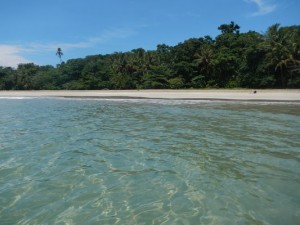
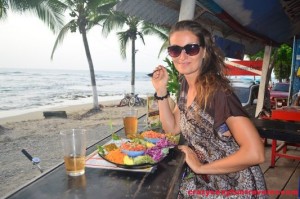


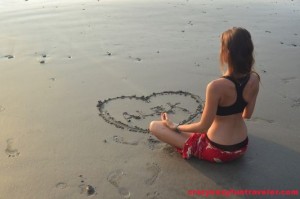
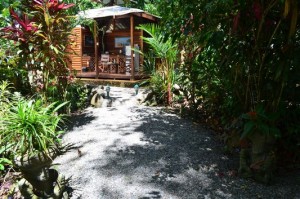
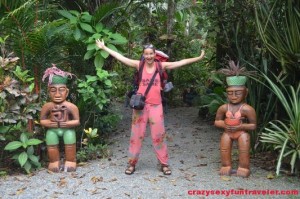
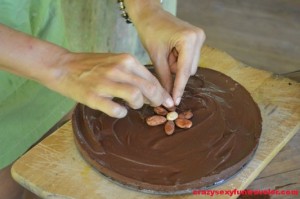
Crazy Sexy Fun Traveler
| #
Comment@ Hans:
Aw, I should be proud of myself then, Hans, right? :) I hope you make it to Bribri one day ;)
Hans
| #
If you were trying to sell me on a tribal tour in Central America, you’ve succeeded. So many pictures and a ton of information … looked like a good time!
Crazy Sexy Fun Traveler
| #
Comment@ Elena:
Thanks, Elena, it was all very fascinating to me too :)
Elena
| #
Wow! Absolutely stunning picture and the story behind them! Walking palms 0 never ever heard of such thing before!